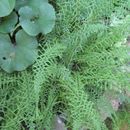I was recently viewing a landscape plan submitted to a former client that is renovating a shade garden. There was an ambiguous blob on the plan labeled as “mixed ferns” which I found perplexing. Have ferns become so mundane that they don’t deserve consideration for their variable features, contributions and stellar texture!? Of course, the answer is that ferns can be a very intentional and impactful addition to any landscape and specificity is warranted. I’m already a stalwart supporter of using the broad palette of native ferns to include maidenhair fern, Christmas fern, cinnamon fern, interrupted fern, sensitive fern and so many more. For a punch of color, I might lean on the various Japanese painted ferns and associated hybrids. However, for an exquisite and noteworthy contribution, do consider the ‘Victoriae’ lady fern (Athyrium filix-femina) which has earned the well-deserved nickname of “Queen of the Ferns.” This is a personal favorite.
Lady ferns are considered circumglobal and are found in the moist woods, fields, meadows and ravines throughout North America, Europe and Asia. There have been many selections of lady ferns introduced to the market over the years. However, in the year 1861, this VERY interesting lady fern was discovered in Scotland. Ultimately named the ‘Victoriae’ lady fern (z 4-8), this amazing cruciate fern has mesmerized many by featuring fronds whose alternate pinnae (leaflets) criss-cross to form many “Xs” (described as “narrow green boomerangs”!) along the rachis (stem). The tips of the pinnae are also crested with a fan-shaped, forked configuration which looks like fringes or tassels. Reaching “24” in height and width, this superb clumping selection has upright stems that cascade at the crested ends. This lacy, filigreed foliage is simply dynamite as an accent in the garden.
This fern can tolerate part shade or deep shade and shrugs off humidity. ‘Victoriae’ can even take a fair amount of sunshine if given ample moisture. This selection seems to tolerate drier soils better than most ferns but really does prefer steady moisture and organic-rich situations with some shelter from the wind (to avoid breakage). However, it is not clay tolerant. Air circulation is still important and it’s notable that this fern is also deer and rabbit resistant.
The ’Victoriae’ lady fern is a sure attention grabber, particularly when placed along path edges or in close proximity to the viewer. Texturally, it reads from a distance but the intricate, dark green foliage entices the viewer closer for more detailed examination and subsequent appreciation. I’ve successfully used this plant as a singular accent but repeated throughout a composition where that texture goes well with hostas, coral bells, lungworts (Pulmonaria), barrenworts (Epimedium) and other denizens of the shade garden. In smaller groupings, it is equally impactful although a frequent challenge is availability which, of course, fluctuates throughout the year. My advice would be to source this plant as early as possible to secure a supply of this unique fern that your shade garden clients will adore. The lady fern selection, ‘Dre’s Dagger’, is thought to be a sport of ‘Victoriae’ and has the identical appearance but on a shorter stature plant reaching 18” in height. Don’t miss the unique potential and contribution of the “Queen of Ferns”!














